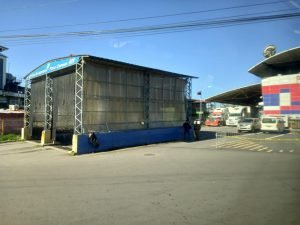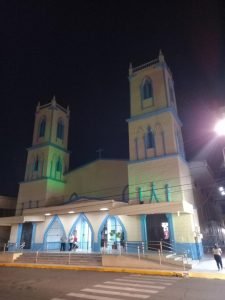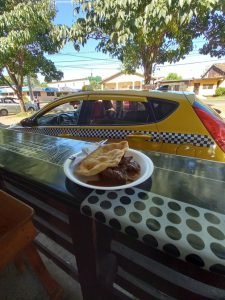A Trip to Panama

WHY PANAMA?
If you’ve been soaking up the charm of Costa Rica’s South Pacific coast for a while, you might feel the urge to escape for the weekend. A quick trip to Panama could be just the thing—especially if you’re low on groceries, alcohol, household goods, or clothes. With its close proximity, Panama makes an ideal spot for a mini holiday.
Traveling to Panama by bus is straightforward, but crossing the border isn’t simple. You’ll face a maze of steps for departure, re-entry, and navigating the frontier. Don’t expect help from your bus driver, and don’t count on signs or English instructions. But once you’ve read this blog, you’ll be ready for a smooth and stress-free weekend visit to David, Panama—just an hour from the Costa Rican border.
REQUIRED DOCUMENTS FOR ENTRY INTO PANAMA
This list is indicative only and you should enquire with proper authorities about what you need to cross the border, especially since things are changing quickly. At the time of writing, all Covid related documentation has been dropped and is no longer required for entry into Panama. In general, be ready with the following:
- Valid Passport (valid to at least 3 months after the date of entry).
- Visa – Check with proper authorities, but most visitors will not need a visa – you will be issued with a stamp indicating how long you can stay in Panama, anywhere between 30 to 180 days, depending on the origin of your passport.
- Return ticket out of Panama (your bus ticket).
- Proof of accommodation in Panama.
- $500 USD cash or proof that you have money, eg. bank statement.
UVITA BUS STATION
Uvita Bus Station
My journey began in Uvita. The bus station sits right in the heart of town, along the coastal highway. Head to the ticket office first—it’s tucked inside a small convenience shop on the left side of the station.
You’ll buy your ticket to David directly from the bus driver when boarding. It costs 12,000 Colones. But you must purchase your return ticket in advance at the ticket office. Bring your passport and keep both printed tickets. They look identical, but the driver will ask for both.
The round trip costs 24,000 Colones, and you’ll need to pay in cash. Oddly, the ticket shows the route starting and ending in San José—not Uvita. Don’t ask me why. The bus company is TRACOPA (Transportes Costarricenses Panameños). Their colorful buses are impossible to miss.
Stay On Your Feet!
Now the fun begins. Fewer than half the buses show their destination, and the station has no screens or PA system. You’re on your own. Ask a driver for the bus number to David. Look for it painted on the sides and rear of the bus.
Sometimes, no one knows the number. You might be told to wait for a “green bus” instead. My bus arrived over an hour late. While I waited, no one could say when it would show up. When it finally pulled in, passengers got off and formed a long line at the cafeteria inside the station. They ate slowly. Nearly 45 minutes passed before boarding resumed.

ON THE WAY TO PASO CANOAS BORDER CROSSING
The bus pulled out at 13:00—well past the advertised 11:00 or 11:30 departure, depending on whom you ask. Tracopa buses are modern and comfortable, but don’t expect toilets or wifi. My bus to David was hot, with no working AC. The return bus had full air conditioning. Thankfully, the windows open, and the breeze helped.
Tip: sit near the front. You’ll be among the first to get off at the border, which means faster immigration. That gives you time to shop, use the toilet, grab a coffee, or just relax while others wait.
The drive from Uvita to the Paso Canoas border took just over two hours. The road winds between the ocean and coastal mountains. Passing lanes are rare. At times, we crawled behind cyclists, overloaded pickups with horses, and slow-moving trucks. There are no stops along the way, so handle everything in Uvita before you board.
PASO CANOAS – CROSSING INTO PANAMA
Costa Rican Customs
This is where things get hectic—and confusing. The bus stopped abruptly on the shoulder of the coastal highway, next to a building. The driver told us to get off and line up. This was the Costa Rican side of the border.
Here, your passport is checked for visa overstay, stamped for exit, and you pay the Costa Rican exit tax. I stepped off the bus and joined the queue, passport and documents ready. After a short wait, I spoke with the Customs officer. He quickly checked and stamped my passport. Then came the twist. A security guard pointed across the road. I approached him, and he told me I had to cross to pay the exit tax.

Exit Tax
The exit tax booth sits directly across the highway. There’s no crosswalk, so you’ll need to weave through heavy traffic with care. The booth is tiny—more like a kiosk—and attached to a restaurant.
You’ll pay $9 USD. It seems Costa Rican nationals don’t have to pay. I was told to pay the tax before seeing the Customs officer, since they may ask for a receipt. I didn’t know that at the time, but had no issues. Still, it’s best to follow the correct order.
You can now pay the exit tax online before your trip. That saves you $1 and a few minutes at the border:


The In-Between
I jogged back across the street and once again spoke to the security guard. He mentioned I need to walk down the highway to the Panamanian border crossing. It was a short 5 minute walk but quite confusing – the border building is not marked as a customs office, and neither are its entrances and exits. You will not find a fence or wall here either, or in fact any sign that you are on the border or any way of knowing where the border is actually located – this is a ‘shared’ area between Panama and Costa Rica, at least in practice. The area is full of shops, vendors, taxis, pedestrians and heavy traffic, total chaos.
Panamanian Customs
I just happened to see a few of my fellow bus passengers lined up in the central building (big structure pained white, blue and red with a PANAMA sign – might have been a clue…) shortly joining them and sweating profusely as we were waiting inside what amounted to a non-air-conditioned greenhouse. The customs process was quick, I was not asked to show any of the documents other than my passport but I did see someone dig in her purse to find the $500 USD requested by the customs officer (on a second trip a few weeks later I was asked for all the documents except the bank statement and everything was checked carefully – so the experience here is very varied).
A photo and fingerprints of both hands were taken via a digital scanner and I was soon on my way to the bus. Our bus was already waiting for us at the side of the building and it did not seem the driver made sure that everyone was onboard before pulling out – so make sure you don’t wonder out too far!
Away We Go!
As we pulled out, the bus went through a bio-security carwash and, a few minutes out of Paso Canoas, a Panamanian border checkpoint – an armed officer entered the bus, had a quick look around and waved us through. We are now on our way to David.




ON THE WAY TO DAVID
After about an hour at the border, we were on our way to David. The scenery changed quickly – jungle, ocean and mountain views morphed into a flat terrain permeated by houses, businesses and strip malls. A welcome addition was a 4-lane highway which made for a fast ride to David – we were there in about an hour, hitting the end of the evening rush hour traffic as we approached the city.
The bus pulled into the main bus station, minutes from town center. I spent the next three days and two nights in David – although there was not much time for exploring, since the first day has just about ended and the third day starts with an 8:30 am bus departure back to Costa Rica.
DAVID
Off the Beaten Track
David is not a tourist town, in fact I can count on one hand the number of foreign tourists I saw during my stay. I spent my time walking around the city – the main square and Miguel de Cervantes Saavedra Park (teeming with giant Iguanas) and the old colonial neighborhood called Barrio Bolivar, where you will find the historic Catedral de San Jose de David. There are a few small casinos in the center of the city and a beach is a short drive away. The local Panamanian currency is the Balboa, however the USD is used and accepted everywhere. I have not seen any Balboa notes, only been given small amounts of Balboa coins as change after paying with USD.
So Cheap…
Prices are low compared to what you would expect to pay in Costa Rica – a beer in an elevated patio bar, with a view of the main square, cost $1.00. Local food is very cheap as well. The center of the city is surrounded by markets and countless clothing and electronics shops. Panama has one of the most advanced public water systems in central America and it is generally considered safe to drink the tap water here – though I did not want to risk it and bought a big jug of spring water at the local supermarket.
Safety
Safety-wise, things felt secure in the immediate center of the city but can get sketch away from the immediate center – I would not recommend venturing out into the historic Barrio Bolivar neighborhood after dark and would be cautious even during the day – as there are not many people around and it did not look like the safest area to explore. Be cautious around the bus station as well – take the same common sense precautions you would take anywhere else. The central city around Miguel Park, however, had a very vibrant and safe vibe.






DEPARTING DAVID
The bus was scheduled to depart at 08:30 from the main bus station in David. I set off early, grabbing a hot coffee on the way. The bus station is a very chaotic place with people, taxis, shops, food carts, vendors, travellers and locals crating a buzzing atmosphere. Most of the buses are mid-sized and white so a big green Tracopa bus was not hard to find. It parked off-side near a grassy knoll making it easy to load the bags and creating a little oasis away from the nearby chaos.





I waited until everyone boarded to make my way on the bus – so that I could pick the unoccupied seat closest to the door, again to help me be one of the first passengers to get through customs (I had seat number 52 printed on the ticket…). I sat down in the 3rd row and, although the tickets showed a printed seat number this did not seem to be enforced until, at the last minute, a family boarded the bus and a young man had to go back from his 2nd row seat to make room for them, after his real seat number was confirmed by the bus driver. We set off right on schedule, this time in the comfort of air conditioning, and made our way to the border.
PASO CANOAS – BORDER CROSSING INTO COSTA RICA
There is not much to say here except the process is the same as before, except reversed. Now, your first stop is the colourful Panamanian customs building – you just go to the other side. Exact same procedure – show your passport, take a picture, scan fingerprints. And this time, there is no exit tax to pay. Then its on to the Costa Rican customs building, where I showed my passport and the ticket out of Costa Rica, and I’m done!
REQUIRED DOCUMENTS FOR ENTRY INTO COSTA RICA
This list is indicative only and you should enquire with proper authorities about what you need to cross the border, especially since things are changing quickly. At the time of writing, all Covid related documentation has been dropped and is no longer required for entry. In general, be ready with the following:
- Valid Passport (valid for at least 6 months after date of arrival)
- Visa – Check with proper authorities, but most visitors will not need a visa – you will be issued with a stamp indicating how long you can stay in Costa Rica, usually 180 days.
- Return ticket out of Costa Rica – should be a bus or airline ticket
- Proof of accommodation in Costa Rica.
- Bank statement showing you have the funds to stay in Costa Rica.
- You need to stay in Panama for at least 72 hours before you are granted a new Costa Rica visa – although I stayed for two nights (around 45 hours), and some people claim one night is still being accepted. Gather your own information about this, but it is always better to be safe vs sorry.
A WORD OF ADVICE
- Double check bus schedules and departure times – often these are conflicting. To be safe show up, with time to spare, for the earliest bus departure time especially since buses have been known to leave early.
- Always read TripAdvisor reviews to be aware of all potential issues – for example pull up the Tracopa review page and read, especially, the 1 or 2 star reviews.
- Always carry around spare change for the toilets – this is not as much an issue in Costa Rica, but is more common in Panama.
- Conflicting information is everywhere – such as entry requirements into both Panama and Costa Rica, bus departure times, minimum length of stay in Panama – check with multiple sources and when it doubt be prepared for the most stringent option.
- Make sure to be careful and aware of your safety and belongings at all times.
A GREAT WEEKEND
I thoroughly enjoyed my trip, it was nice to see another country and get a bit of a break from the jungle. I will definitely be going back in a few months for another round of shopping and cheap beer!
A weekend trip is nice but we are always happy and excited to make our way back to the South Pacific corner of Costa Rica – those who live here can tell you that they have travelled all over the world but nowhere could they find a spot that had a better mix of wilderness, spectacular scenery, beaches, amenities, lifestyle and vibe – nothing comes even close! They know it and you know it too – start your life-changing journey with an email or phone call to RE/MAX We Sell Paradise – visit them here. In the meantime, feel free to browse our local property listings.



